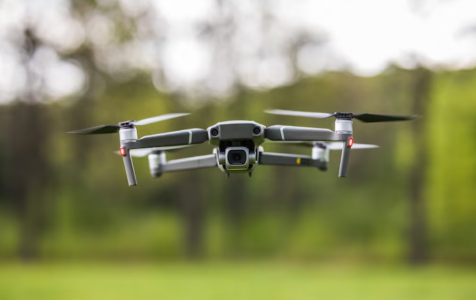Popular online purchase poses worrying risk: 'The problem is not going away'
By
Gian T
- Replies 1
If you’ve ever browsed Temu, Amazon, or AliExpress for a nifty gadget or a bargain, you’re not alone—these online marketplaces have become a go-to for everything from kitchen tools to tech toys.
But did you know that some of the most innocent-looking items for sale could pose a serious threat to public safety and national security?
It’s a worrying trend that’s flying under the radar, and it’s time we all took a closer look.
It’s no secret that drones have soared in popularity over the past few years.
They’re fun, useful for photography, and even handy for checking the gutters!
But experts are sounding the alarm: the same technology that lets you snap a bird’s-eye view of your backyard can also be misused in dangerous ways.
Dr Oleksandra Molloy, a senior lecturer in aviation at the University of New South Wales, warns that drones have become an 'emerging threat.'
When combined with certain accessories—many of which are easily found online—they can be turned into tools for surveillance or, worse, weapons capable of causing real harm.
A quick search for 'drone accessories' on Temu or Amazon brings up hundreds of results: spare propellers, camera mounts, and batteries.
But hidden among these are items that mimic military equipment, such as high-powered antennas, payload release devices, thermal cameras, and even AI modules.
Some of these are nearly identical to the parts being used in the ongoing conflict in Ukraine.
Shockingly easy. Online marketplaces have made it possible to bypass traditional export controls, allowing anyone in Australia to order high-resolution thermal cameras, long-range antennas, or powerful motors with just a few clicks.
These components can be used to assemble drones capable of conducting surveillance or even carrying out attacks.
John Blaxland, an international security and intelligence expert, says this is a classic case of 'dual use' technology—products designed for innocent purposes that can be quickly adapted for more sinister uses.
'It’s devilishly difficult to regulate and police in this space, where minor tweaks turn something built for commercial purposes into a weapon of war,' he explains.
It’s not just theory. Investigations by security firms, such as Red Balloon, have found that low-cost add-ons for commercial drones are readily available on Chinese e-commerce platforms.
Some of these accessories have already been used in the Russia-Ukraine conflict, including AI guidance modules and fibre optic tethers that resist signal jamming.
There have also been alarming incidents closer to home. In the US, a man was arrested for planning to bomb a power grid using a drone loaded with explosives.
Terror groups in the Middle East have used commercial drones to drop grenades and deliver payloads.
The low cost and easy availability of these parts have made such repurposing increasingly common in modern warfare and terrorism.
Unfortunately, Australia lags behind other countries in regulating these risks. Dr Molloy points out that we don’t have the same 'country-of-origin bans' as the US, which prevent government agencies from using drones or parts from high-risk countries like China.
This leaves us vulnerable to data breaches and other security threats.
While the Defence and Strategic Goods List sets limits on military-grade exports, experts say it needs to be updated to address the risk of commercial components being abused domestically.
As Blaxland notes, 'the problem is not going away' and will likely become more acute as technology advances and 3D printing makes it even easier to manufacture parts locally.
For most of us, the idea of accidentally buying something dangerous online seems far-fetched.
But it’s a good reminder to be cautious about what we purchase and where it comes from.
If you’re shopping for tech gadgets, especially drones or their accessories, stick to reputable brands and sellers.
Be wary of deals that seem too good to be true, and always check the product details and reviews.
If you’re concerned about a product you’ve seen online, you can report it to the Australian Cyber Security Centre or your local authorities.
And remember, just because something is for sale doesn’t mean it’s safe or legal to use in every way imaginable.
Online shopping has made life easier in so many ways, but it’s also opened the door to new risks that we all need to be aware of.
As technology continues to evolve, so too do the ways it can be misused. Staying informed and vigilant is the best way to protect yourself—and your community.
 Have you ever come across a suspicious gadget online, or do you have concerns about the safety of certain tech products? We’d love to hear your thoughts and experiences in the comments below.
Have you ever come across a suspicious gadget online, or do you have concerns about the safety of certain tech products? We’d love to hear your thoughts and experiences in the comments below.
But did you know that some of the most innocent-looking items for sale could pose a serious threat to public safety and national security?
It’s a worrying trend that’s flying under the radar, and it’s time we all took a closer look.
It’s no secret that drones have soared in popularity over the past few years.
They’re fun, useful for photography, and even handy for checking the gutters!
But experts are sounding the alarm: the same technology that lets you snap a bird’s-eye view of your backyard can also be misused in dangerous ways.
Dr Oleksandra Molloy, a senior lecturer in aviation at the University of New South Wales, warns that drones have become an 'emerging threat.'
When combined with certain accessories—many of which are easily found online—they can be turned into tools for surveillance or, worse, weapons capable of causing real harm.
A quick search for 'drone accessories' on Temu or Amazon brings up hundreds of results: spare propellers, camera mounts, and batteries.
But hidden among these are items that mimic military equipment, such as high-powered antennas, payload release devices, thermal cameras, and even AI modules.
Some of these are nearly identical to the parts being used in the ongoing conflict in Ukraine.
Shockingly easy. Online marketplaces have made it possible to bypass traditional export controls, allowing anyone in Australia to order high-resolution thermal cameras, long-range antennas, or powerful motors with just a few clicks.
These components can be used to assemble drones capable of conducting surveillance or even carrying out attacks.
John Blaxland, an international security and intelligence expert, says this is a classic case of 'dual use' technology—products designed for innocent purposes that can be quickly adapted for more sinister uses.
'It’s devilishly difficult to regulate and police in this space, where minor tweaks turn something built for commercial purposes into a weapon of war,' he explains.
Some of these accessories have already been used in the Russia-Ukraine conflict, including AI guidance modules and fibre optic tethers that resist signal jamming.
There have also been alarming incidents closer to home. In the US, a man was arrested for planning to bomb a power grid using a drone loaded with explosives.
Terror groups in the Middle East have used commercial drones to drop grenades and deliver payloads.
The low cost and easy availability of these parts have made such repurposing increasingly common in modern warfare and terrorism.
Unfortunately, Australia lags behind other countries in regulating these risks. Dr Molloy points out that we don’t have the same 'country-of-origin bans' as the US, which prevent government agencies from using drones or parts from high-risk countries like China.
While the Defence and Strategic Goods List sets limits on military-grade exports, experts say it needs to be updated to address the risk of commercial components being abused domestically.
As Blaxland notes, 'the problem is not going away' and will likely become more acute as technology advances and 3D printing makes it even easier to manufacture parts locally.
For most of us, the idea of accidentally buying something dangerous online seems far-fetched.
But it’s a good reminder to be cautious about what we purchase and where it comes from.
If you’re shopping for tech gadgets, especially drones or their accessories, stick to reputable brands and sellers.
If you’re concerned about a product you’ve seen online, you can report it to the Australian Cyber Security Centre or your local authorities.
And remember, just because something is for sale doesn’t mean it’s safe or legal to use in every way imaginable.
Online shopping has made life easier in so many ways, but it’s also opened the door to new risks that we all need to be aware of.
As technology continues to evolve, so too do the ways it can be misused. Staying informed and vigilant is the best way to protect yourself—and your community.
Key Takeaways
- Online marketplaces like Temu, Amazon, and AliExpress are selling drone accessories and gadgets that can be weaponised, raising serious public safety and national security concerns in Australia.
- Experts warn that high-powered and military-style drone components—such as thermal cameras, payload devices, and AI modules—are easily accessible and often identical to those used in modern warzones like Ukraine.
- Australia is lagging behind countries like the US in regulating the import and use of high-risk drone parts, with current laws and export controls not keeping pace with the rapid growth of commercial off-the-shelf components that can be repurposed for harmful purposes.
- Security specialists believe the problem is expected to worsen due to the ease of bypassing export restrictions online, as well as new threats from local manufacturing and 3D printing, prompting urgent calls for tougher laws and enforcement.








